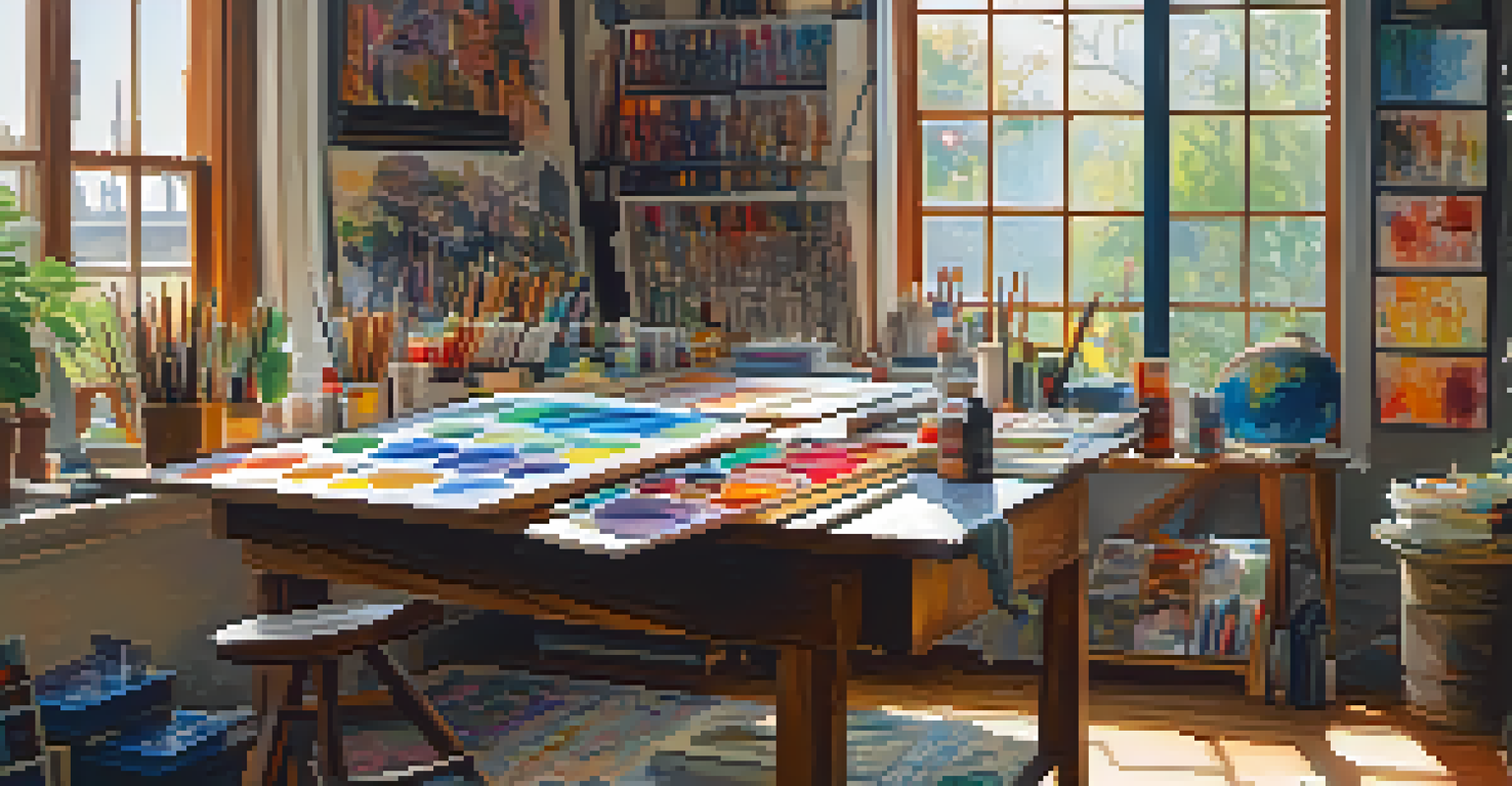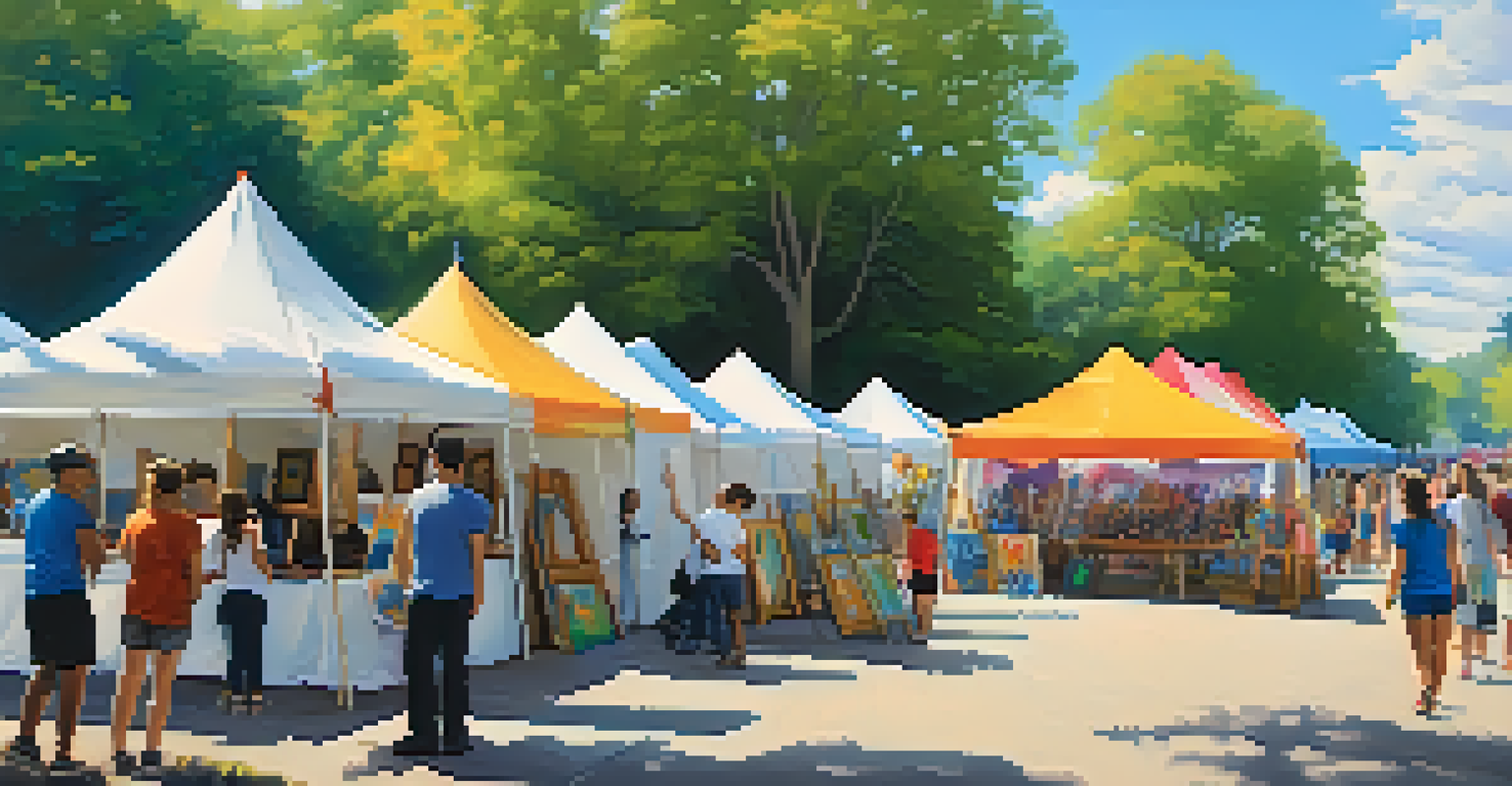The Role of Art in Cultural Diplomacy and Exchange

Understanding Cultural Diplomacy and Its Importance
Cultural diplomacy is a way countries engage with each other through culture, often using art, music, and literature as tools. This approach helps build mutual respect and understanding, which are crucial in today’s interconnected world. By showcasing their cultural heritage, nations can foster goodwill and create lasting relationships.
Art is the most beautiful of all lies; it is the truth of the heart.
For instance, when a country shares its traditional music or dance at international festivals, it opens up a dialogue that transcends political boundaries. This exchange allows people to appreciate different perspectives, creating a foundation for collaboration and peace. Ultimately, cultural diplomacy emphasizes the shared human experience over differences.
Moreover, the arts can serve as a bridge during political tensions, reminding us of our common humanity. When people connect through art, they are more likely to view each other with empathy and understanding, laying the groundwork for constructive international relations.
The Power of Art in Bridging Cultural Gaps
Art has a unique ability to convey complex ideas and emotions without the need for words, making it an effective medium for cultural exchange. Whether it’s through paintings, sculptures, or performances, art can evoke feelings that resonate across different cultures. This universality helps dismantle stereotypes and fosters a deeper appreciation for diversity.

Consider the impact of street art in urban environments where artists from various backgrounds collaborate. These vibrant murals often tell stories that reflect the community's shared experiences and struggles, inviting dialogue among people who might never otherwise meet. Through such projects, art becomes a shared language that promotes understanding and unity.
Cultural Diplomacy Builds Connections
Cultural diplomacy fosters mutual respect and understanding among nations through the sharing of art, music, and literature.
Additionally, art exhibitions that feature works from multiple cultures allow audiences to engage with different narratives. This exposure not only enriches the viewer’s perspective but also highlights the interconnectedness of global communities, reinforcing the idea that we are all part of a larger human tapestry.
Art as a Tool for Peacebuilding and Conflict Resolution
In times of conflict, art can serve as a powerful tool for reconciliation and healing. Creative expressions often provide a safe space for individuals to process their emotions and share their stories. By encouraging dialogue through artistic collaboration, communities can begin to rebuild trust and understanding.
Culture is the widening of the mind and of the spirit.
For example, programs that bring together artists from conflicting regions can create a platform for shared expression and dialogue. These initiatives often result in powerful works that reflect the pain of conflict while also envisioning a hopeful future. Such artistic endeavors highlight the potential for peace and collaboration, even in the darkest times.
Moreover, art therapy has become an essential part of post-conflict recovery, helping individuals cope with trauma through creative outlets. By harnessing the transformative power of art, communities can foster healing and pave the way for a more peaceful coexistence.
Global Festivals: Celebrating Cultural Diversity Through Art
Global art festivals are a vibrant showcase of cultural diplomacy in action. These events bring together artists from around the world, allowing them to share their unique perspectives and talents. Through performances, exhibitions, and workshops, participants can experience the richness of diverse cultures firsthand.
Take the Edinburgh Festival Fringe, for example, which celebrates artistic expression from various nations. It invites performers to share their work in an inclusive environment, promoting cultural exchange and understanding. Such festivals not only entertain but also educate audiences about different cultural practices and traditions.
Art Bridges Cultural Divides
Art acts as a universal language, promoting empathy and appreciation for diversity while dismantling stereotypes.
Additionally, these gatherings foster international collaboration, inspiring artists to explore and incorporate elements from other cultures into their work. This blending of artistic practices enriches the global arts scene and reinforces the idea that creativity knows no borders.
The Role of Technology in Cultural Exchange Through Art
In our digital age, technology plays a crucial role in facilitating cultural exchange through art. Online platforms enable artists to reach global audiences, breaking down geographical barriers. Virtual exhibitions and performances can showcase diverse artistic expressions, making them accessible to anyone with an internet connection.
For instance, social media has become a powerful tool for artists to share their work and connect with like-minded individuals worldwide. Artists can collaborate across continents, sharing ideas and techniques that enrich their creative processes. This digital interaction fosters a sense of global community and encourages cultural appreciation.
Moreover, technology allows for innovative approaches to art, such as virtual reality installations that immerse viewers in different cultural experiences. These advancements not only enhance engagement but also deepen understanding, allowing audiences to explore and appreciate the nuances of various cultures.
Educational Initiatives: Promoting Cultural Understanding Through Art
Educational initiatives play a pivotal role in promoting cultural understanding through art. Schools and community programs that incorporate art education help students appreciate diverse cultures from an early age. By engaging with different artistic traditions, young people can develop empathy and respect for others.
For example, workshops that focus on traditional crafts from various cultures allow students to experience the history and significance behind each art form. This hands-on approach not only fosters creativity but also encourages curiosity about global cultures, bridging gaps between communities.
Technology Enhances Cultural Exchange
In the digital age, technology facilitates global access to art, allowing for innovative collaborations and cultural appreciation.
Additionally, integrating art into curricula can empower students to express their identities and share their unique stories. This exchange of personal narratives promotes dialogue and understanding, emphasizing the importance of cultural diversity in our increasingly interconnected world.
The Future of Art in Cultural Diplomacy and Exchange
As the world continues to evolve, the role of art in cultural diplomacy and exchange will only become more significant. With rising globalization, the need for understanding and cooperation among cultures is paramount. Art will remain a vital tool for fostering connections and addressing global challenges.
Moreover, the ongoing advancements in technology will further enhance the ways we share and experience art. Virtual and augmented reality experiences could allow individuals to immerse themselves in different cultures, promoting empathy and understanding on an unprecedented scale. This evolution will likely lead to even more innovative forms of cultural exchange.

Ultimately, the future of cultural diplomacy through art lies in collaboration and inclusivity. By embracing the diverse voices of artists worldwide, we can continue to build bridges, celebrate our differences, and create a more harmonious global community.